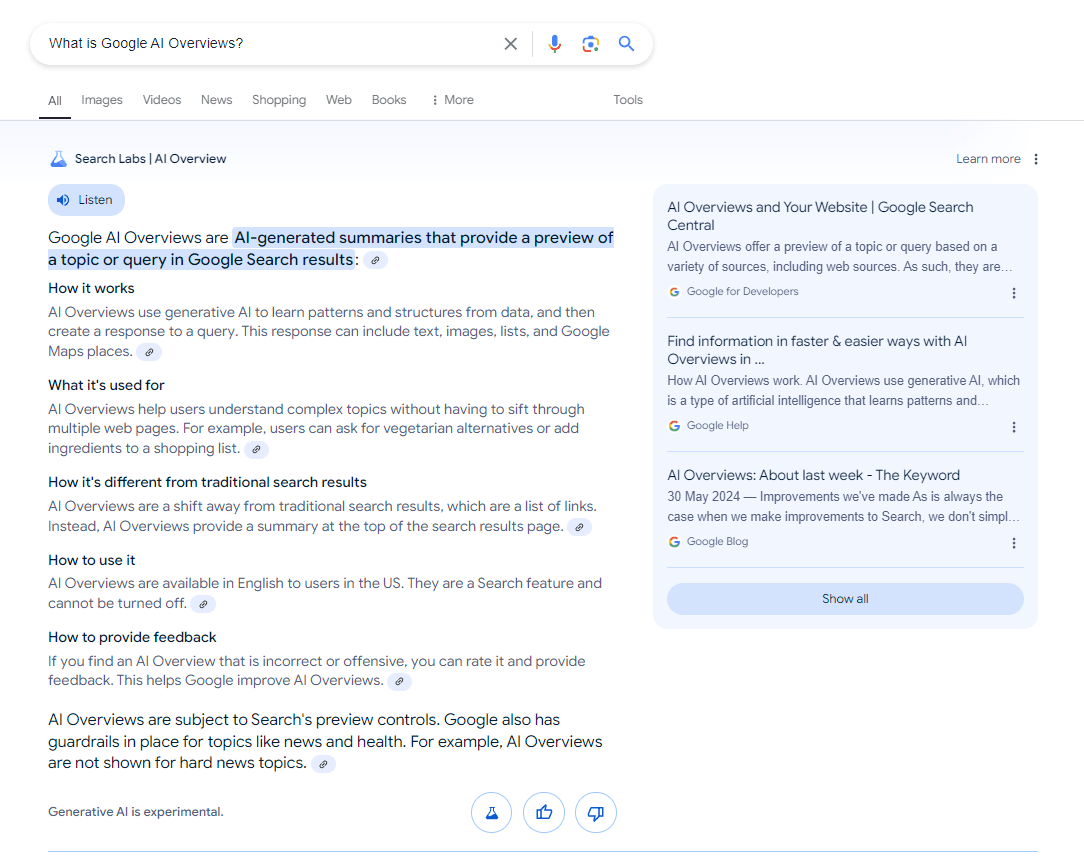In the rapidly evolving digital landscape, Google’s introduction of the Generative AI in Search marks a pivotal shift in how users interact with search engines.
This breakthrough, blending AI-generated content with search intent, is set to redefine the benchmarks for user experience and content relevance.
As Google AI Overviews weaves together comprehensive answers generated in real-time, tailored to the nuanced needs of each query, understanding its mechanics and implications becomes crucial for anyone looking to stay ahead in the digital domain.
The integration of generative search into Google’s powerful engine signals a move towards more personalized, accurate, and conversational interactions between users and information, rendering traditional search mechanisms almost obsolete.
This article delves into the core of the Search Generative Experience, unpacking how it works, its benefits, and the potential downsides.
For businesses and SEO professionals, understanding the seismic SEO impact of Google’s SGE from content optimization, and leveraging structured data, to enhancing content quality for SGE rankings will be paramount.
Navigating Generative AI in SEO teaches you to adapt and thrive in the new era of search.
What Are AI Overviews?

The Search Generative Experience (Google SGE) is an experimental search approach introduced by Google that utilizes generative artificial intelligence (AI) to provide users with quick and clear topic overviews without the need to visit individual webpages.
The purpose of Google SGE is to help users find answers, discover topic overviews, summarize key takeaways, and obtain how-to instructions.
It aims to simplify the search process by offering users an easy-to-understand summary of complex topics, conversational results, and fast, direct information.
AI-Driven Features in SGE
- AI Snapshot: At the top of the Google search engine results page (SERP), the AI-generated snippet, known as the AI snapshot, directly answers user queries. This feature provides immediate, concise answers without the need for users to navigate through links.
- Conversational Mode: SGE supports follow-up questions, maintaining the context of the original search. This allows for a dynamic and interactive exchange of information, making the search process more intuitive and user-friendly.
- Vertical Experiences: In commercial searches, SGE offers a tailored list of features and detailed product information, enhancing the shopping experience directly from the search results.
- Generative AI Integration: Utilizing a large language model, specifically the Pathways Language Model (Palm) 2, SGE processes and generates responses that are not only relevant but also contextually enriched. This model is trained on extensive data sets and employs a transformer neural network to predict and formulate answers effectively.
How SGE Will Impact Search Results
When Google implements their new Search Generative Experience (SGE) in 2024, it will significantly impact how search results are ranked and displayed. As an SEO, you’ll need to make key changes to your content and technical SEO to adapt.
Practical Implications of SGE
SGE represents a significant shift from traditional search methods by providing quick, AI-formulated answers and comprehensive overviews directly in the SERP.
This reduces the need for users to click through to individual websites, streamlining the information retrieval process.
For instance, if you’re searching for activities on a rainy day for kids, SGE would immediately present a compiled list of suggestions at the top of the results, sourced from multiple references.
Source Integration and Transparency
Next to the search results, Google SGE displays the sources of the information, allowing users to explore further if they choose. This transparency helps build trust and provides a pathway for users to verify the information provided by the AI.
Personalized Results
With SGE, Google aims to provide ultra-personalized search results tailored to each individual searcher. Ranking signals will factor in a user’s location, search history, and personal preferences gleaned from their Google accounts and devices.
They already track your search history, location, and preferences to serve up relevant results. In the future, Google may use even more data to provide hyper-personalized search experiences.
Visual-First Interface
The Google SGE interface will rely much more heavily on visuals like images, video, and interactive elements. Static text-based content will be deprioritized in the search results.
To adapt, you’ll need to incorporate more visual media into your content. Photos, graphics, video, and interactive tools should be a core part of your content strategy.
Pay close attention to proper image optimization, video SEO, and making your visuals accessible. The content with the most engaging visuals will rank higher in SGE.
Impact of SGE on SEO
Potential Reduction in Organic Traffic
The introduction of Google’s Search Generative Experience (SGE) has significantly shifted the dynamics of search results, particularly affecting organic traffic. As SGE provides required answers directly within the search engine results pages (SERPs), users are less inclined to click through to individual websites.
Recent studies indicate that zero-click searches have risen, with a substantial percentage of searches on mobile and desktop ending without any clicks on the results.
This trend is particularly pronounced for local businesses and immediate conversion queries where SGE often delivers the necessary information right on the SERPs.
Increased Quality of Leads
Despite the potential reduction in overall traffic, the quality of leads may improve. Google SGE tends to filter user queries more effectively, directing users with specific intents such as final purchases or detailed inquiries.
This shift can lead to more qualified traffic reaching websites, particularly for complex or niche queries where users seek in-depth information before making a decision.
Therefore, while the quantity of site visits may decrease, the quality and conversion potential of the traffic could increase, offering a more targeted audience to businesses.
The Balance Between Generative and Traditional Search Results
The balance between generative and traditional search results is a critical area impacted by SGE. While Google SGE enhances the user experience by quickly providing relevant information, it also challenges the visibility of traditional organic results. High-ranking organic results are now more likely to compete with AI-generated responses, which often take precedence on the SERPs.
However, this doesn’t eliminate the importance of traditional SEO efforts. High-quality content that answers specific user queries remains crucial and can still gain visibility if it aligns well with the generative results provided by SGE.
How Does the Search Generative Experience (SGE) Work?
The Search Generative Experience or SGE will change how Google search results are generated and displayed. Instead of just retrieving and ranking web pages based on relevancy, the SGE will actually generate new content on the fly using AI.
Understanding Your Intent
The Google SGE will try to gain a deeper understanding of the intent behind your search query. It will analyze the words and phrases you enter to determine what type of information or media you’re likely looking for – things like news articles, video tutorials, podcast episodes, or social media posts. The SGE can then generate customized content to match your needs.
Generating New Content
The Google SGE doesn’t just rearrange existing web content. It creates entirely new paragraphs, lists, images, and media using AI.
Google Search Generative Experience relies on generative AI technology, including natural language processing, machine learning, and deep learning, to understand user queries, process content, and provide appropriate responses.
When users perform a search, Google SGE generates a single answer or snippet that appears at the top of the search engine results page (SERP). This generated snippet is designed to provide a summary or overview of the search query, eliminating the need for users to click on individual website links.
Users can interact with SGE by asking follow-up questions based on the generated answer.
Google SGE also offers product recommendations and clear instructions on how to perform tasks related to the search query. This conversational aspect of SGE allows for a more personalized and interactive search experience.
The content is generated on demand for your specific search so it will feel highly customized and targeted.
However, since the content is computer-generated, it may lack the depth and nuance of human-created content. The quality will likely improve over time as the AI continues to learn.
Providing a Seamless Experience
The goal of the SGE is to provide a seamless search-to-content experience. Instead of sifting through pages of blue links, the most relevant information is instantly generated and displayed for you.
The content is also optimized for the device you’re using, whether it’s a desktop computer, smartphone or voice assistant.
Over time, the Google SGE will get to know you and your preferences to deliver an increasingly personalized experience.
Benefits of the Search Generative Experience (SGE)
The Search Generative Experience or Google SGE will significantly enhance how people discover and explore information online. Some of the key benefits of SGE include:
Personalized Search Results
SGE will generate search results tailored to each individual based on their interests, location, search history and more. This means you’ll get more relevant results for your specific needs.
Say you’re planning a trip to Paris, SGE will surface results related to flights, hotels, attractions, restaurants and so on in Paris to help you research your trip.
Provides Simple Explanations of Questions
One of the main advantages of SGE is its ability to provide users with a simple overview of complex topics. Instead of having to read through multiple webpages to understand a subject, SGE generates a concise summary that captures the key points of the topic.
This feature is particularly useful for users who are looking for quick answers or who want to gain a general understanding of a subject before diving into more detailed information.
Quick and Clear Answers
Google SGE provides users with fast and direct information. The generated answer appears at the top of the SERP, eliminating the need to scroll through multiple search results.
Users can quickly access the information they are looking for without having to navigate to external websites. This feature saves users time and makes the search process more efficient.
For example, product research becomes more efficient as SGE can fetch and summarize specifications and reviews from multiple sources in a concise format, often within a 30- to 90-second read. This rapid delivery of information makes the search experience not only faster but also more addictive.
Personalized Content Discovery
Google SGE gets smarter over time by understanding your interests and preferences. It will proactively recommend content, products, media and more tailored to you. Rather than having to search for new things that match your tastes, SGE brings them directly to you.
This makes it easy to discover new interests and stay on the cutting edge of topics that matter to you.
Conversational Mode
SGE enables users to have a more conversational search experience. Users can ask follow-up questions based on the initial answer generated by SGE, allowing for a more interactive and dynamic search session.
This conversational aspect enhances the user experience and provides users with the opportunity to clarify their queries or explore related topics.
Visual Search
Rather than relying solely on text, Google SGE incorporates visual search so you can search using images. Snap a photo of something that interests you, like a plant or piece of furniture, and SGE will find related images, products to buy and information to help identify what it is. Visual search makes discovering the world around you more engaging and intuitive.
Voice Search
Google SGE has been optimized for voice search, allowing you to simply ask questions and get answers using natural language.
You can ask broader questions and SGE will understand the context to provide relevant responses, rather than just a list of links. Voice search through SGE provides a hands-free way to get information on the go.
SGE also provides the option to convert the generated text answers into voice answers, so that users can listen to the information directly instead of reading it.
Drawbacks of the Search Generative Experience (SGE)
While SGE will likely transform search in exciting ways, it also brings some potential downsides to consider.
Not Suitable for All Queries
Despite its advanced capabilities, not all search queries trigger an SGE result. Research indicates that approximately 15% of searches do not engage SGE, often related to straightforward product or service inquiries.
This inconsistency can impact the effectiveness of SGE for certain types of searches, particularly those requiring direct answers or transactions.
Paid Search Becomes Less Effective
With Google SGE providing direct answers within the search results, traditional paid search ads may experience reduced visibility. This could lead to a decrease in click-through rates (CTR) and potentially higher costs per click (CPC) as advertisers compete for limited ad space on the SERPs.
The shift might necessitate new ad formats and placements to maintain relevance and effectiveness in the evolving search landscape.
Bias and Unfairness
If not designed properly, AI systems can reflect and even amplify the biases of their training data. SGE may end up favoring certain demographic groups over others or promoting harmful stereotypes. Google will need to make AI fairness a priority to avoid discrimination in search results.
Information Overload
By generating many possible results for a query, SGE could overwhelm users with too many options. While more choice seems appealing, too much information can paradoxically make it harder to find what you really need.
Google may need to find the right balance between variety and relevance.
Possibility of Inaccuracy
SGE, like other AI-driven tools, is susceptible to producing incorrect information due to what is known as “AI hallucinations.” These errors occur when the AI misinterprets data or overgeneralizes from its training material, leading to responses that are not factually accurate.
No Transparency
SGE operates on a closed model called PaLM 2, which means that Google does not disclose detailed information about its decision-making process.
This lack of transparency may make it challenging for users to understand how SGE arrives at a particular answer or conclusion. Users may be left wondering about the factors and algorithms used by SGE to generate the answers.
Additionally, the issue of source attribution in AI-generated summaries raises concerns about the clarity and credibility of the information presented.
How Does SGE Compare to Similar AI-Powered Tools?
There are several AI-powered tools and platforms in the market that aim to enhance the search experience. Here are a few comparisons between SGE and some similar tools:
Google SGE vs. ChatGPT
ChatGPT is a chatbot developed by OpenAI that uses a large language model to generate conversational responses.
While both SGE and ChatGPT involve generative AI, SGE focuses on providing quick and clear topic overviews in search results, while ChatGPT is designed for more interactive and dynamic conversations.
While Google SGE integrates directly into the search engine, providing generative AI responses at the top of the search results page, ChatGPT typically offers more comprehensive responses, which may require longer wait times.
SGE operates within the Google Search ecosystem, while ChatGPT can be integrated into various platforms and applications.
Google SGE vs. Perplexity AI
Perplexity AI is another generative search engine that utilizes advanced AI and natural language processing technologies to provide users with an ad-free search experience.
While both SGE and Perplexity AI generate answers to search queries, SGE includes advertisements and is still in the experimental phase, limiting its accessibility. Perplexity AI focuses on synthesizing information from diverse sources and offers a more in-depth understanding of complex subjects.
Google SGE vs. Bing Copilot
Bing Copilot, particularly Bing Chat, highlights distinct approaches to integrating AI into search tools. Bing Chat enriches its AI responses with numerous source links, enhancing transparency and trust among users.
Google SGE, while often updating and improving, sometimes provides redundant information already available through other Google SERP features like Featured Snippets.
Bing’s layout allows users to access traditional search results alongside AI-generated responses, which some users might find more user-friendly. Despite these differences, both platforms are continuously evolving, aiming to refine user experience with AI-powered search capabilities.
How to Optimize for Search Generative Experience
Google SGE is expected to have significant implications for search engine optimization (SEO). Website owners and SEO professionals need to adapt their strategies to optimize for SGE and maintain visibility in search results. Here are some key changes and considerations in SEO:
Optimizing for Conversational Search Queries
To rank well for conversational search queries in 2024, you’ll want to optimize your content for natural language and voice search. Focus on creating helpful, empathetic content that answers common questions in a friendly tone.
When people search with their voice or in natural language, they’re more likely to use full questions or sentences to express what they’re looking for. Optimize your page titles, headings, and content for long-tail keyphrases and questions that include natural language.
For example, instead of just “SEO tips,” use “What are some helpful SEO tips for my website?”
Structure your content in a Q&A format when possible. This makes it easy for search engines to understand how your page answers a searcher’s question.
You can start each section or paragraph with a question, then provide a thoughtful answer in your own words. Use transition words like additionally, moreover and furthermore to connect related ideas.
Use a welcoming and helpful tone in your writing. Speak directly to the reader using words like you and your. Explain concepts clearly without sounding pushy or salesy. Your goal is to provide value to searchers, not just promote your business or services.
Include diverse content that’s inclusive of all searchers. Content that’s biased or insensitive will rank lower in search engines, so steer clear of harmful assumptions and stereotypes.
The Role of Semantics and Entity Understanding
In 2024, Google Search will have a much deeper understanding of the meaning and relationships between words, phrases and concepts on pages. This is known as semantics.
Google’s knowledge graph contains entities, attributes and connections between topics which allows their AI to better grasp what content is truly about.
For SEO, focusing on semantics means using synonyms and related terms throughout your content. Mention all aspects of a topic by incorporating semantically-linked words and phrases. Explain concepts thoroughly while linking to authoritative sources.
Google’s entity understanding in 2024 will be highly advanced. They will comprehend the topic or subject of each page in detail, not just based on a few keywords.
Optimize for entities by incorporating phrases to represent topics, ideas or objects in your niche. Discuss the attributes, properties and characteristics of each entity. Show how entities connect or relate to each other.
To rank well in 2024, you must convey a clear understanding of semantics and entities in your content. Describe topics using a rich variety of words, explain concepts comprehensively and demonstrate how entities associate or interact. Google’s AI will ask sophisticated questions to determine if pages exhibit a profound grasp of meaning, topics and relationships.
Creating Useful, Helpful Content for Users
To rank well in Google’s generative search experience, focus on creating content that provides real value to users.
Think about the questions and needs people have, and build content that answers those questions in a helpful, empathetic way.
Some key things to keep in mind:
Provide practical, actionable advice and how-to guidance. Walk readers through processes step-by-step, offering specific tips and recommendations they can apply. For example, if writing about SEO in 2024, give concrete examples of optimization techniques they can start using now to prepare.
Share both broad overviews and in-depth insights. Having a mix of beginner, intermediate and advanced content will serve more users at different levels of understanding. Briefly explain concepts and then link to more comprehensive posts for those wanting to dive deeper.
Use an engaging yet authoritative tone. Write in a friendly, conversational style but back up points with facts and expert opinions. Referencing reputable sources builds trust and helps establish you as a knowledgeable guide.
Include visuals like images, graphics, and video. Generative engines can generate written content but still struggle with effectively incorporating visual media. Curating and creating visual aids enhances the user experience and gives your content a more authentic feel.
Keep your content up-to-date. Generative search indexes new information in real-time, so continuously updating older posts with the latest data, advice and examples is key. Make updating a regular part of your content creation workflow.
Think about how to provide the most helpful, empathetic and practical solution or advice for the user. Generative search rewards content that genuinely aims to inform, educate and improve people’s lives rather than just rank well in search engines.
Analyze SGE Result for Targeted Keywords
To effectively optimize for Google’s Search Generative Experience (SGE), start by analyzing how SGE displays results for your targeted keywords.
Understanding how SGE responds to specific queries can help you refine your content and optimize it for better visibility.
This involves understanding the types of answers provided and ensuring your content aligns with these results. By targeting the keywords that SGE frequently uses, you can increase the visibility of your content in these AI-driven search results.
Respond Directly to User Queries in the Content
SGE thrives on providing quick answers and direct information. When creating content, consider incorporating direct responses to common user queries related to your topic. By addressing these queries directly within your content, you increase the chances of being featured in the generated answers by SGE.
Use headers to clearly state these questions and provide concise, informative answers within your content. This method not only helps with SGE but also improves traditional SEO by making your content more accessible and easier to understand.
Use Natural Language
SGE emphasizes natural language processing and understanding. To optimize for SGE, it is recommended to use natural language in your content. Avoid keyword stuffing and focus on delivering information in a conversational and easy-to-understand manner.
This approach is also beneficial for voice search optimization, which is becoming increasingly popular.
Target Long-Tail Keywords
Optimizing your content for long-tail keywords those specific, often longer phrases used by searchers can dramatically improve your visibility in SGE results.
These keywords are less competitive and more targeted, making them more effective for capturing specific search intents.
SGE aims to provide targeted and specific answers to user queries. By targeting long-tail keywords in your content, you increase the chances of being featured in the generated answers for those specific queries.
Use Structured Data
Implementing structured data (schema markup) is a powerful way to help search engines understand the content of your pages better. By providing explicit clues about the meaning of your content through structured data, you enhance the ability of SGE to accurately feature your content in its AI-generated summaries.
This not only boosts your content’s visibility in search results but also improves the overall user experience by providing clearer, more relevant information.
It is important to note that these SEO strategies should be implemented alongside traditional SEO practices to ensure holistic optimization for both SGE and traditional search results.
Conclusion
Search Generative Experience (SGE) – Google’s search based question answering Engine which is going to change the way people search information online. By prioritizing speed, concise topic summaries, conversational output, and direct delivery, SGE is streamlining the search process and providing a better experience for the user.
But there are potential shortcomings to SGE that publishers should know – geographic limitations, potential inaccuracies, and limited support for sites.
With the inclusion of Google’s Search Generative Experience (SGE), the evolution of search technology has passed another checkpoint, and the future of AI-based personalization and efficiency in search queries is closer than ever to being universal.
And thus, we study the inner mechanisms of this trend, its impact, and the strategic shifts needed to successfully transition to SGE, to uncover the unprecedented impact of SGE on SEO practices and user engagement models.
It is crucial to stay updated with the changes in search technology and continuously refine SEO strategies to ensure visibility and competitiveness in the evolving search landscape.





